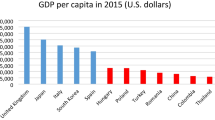Abstract
The aim of this work is to study whether a process of convergence in innovation in the European countries has occurred or not, by analysing the relative changes in the innovative position of the European countries during the period 2002–2006. Special attention is paid to the relative changes that have occurred in the recently acceded countries and to the poorest countries of the EU-15. The data used in this research come from the fourth and fifth wave of the Community Innovation Survey elaborated by EUROSTAT and collected in different Member States of the European Union. The statistical technique used is the multiple factorial analysis. The study has been carried out on two different sets of firms. On the one hand, it has considered all manufacturing firms (innovative and non-innovative firms) and, on the other, only the innovative manufacturing firms. The results show a moderate convergence process in innovation in the manufacturing as a whole, but not in the innovative firms.





Similar content being viewed by others
Notes
The definition of innovation that is used in the two waves of the CIS is harmonized. It is considered that a firm is innovative when the firm has introduced new or improved products on the market or it has implemented new or improved processes. The term includes all types of innovation: product innovation and process innovation.
Note that for continuous variables AFM behaves as an ACP (weighted variables) and for nominal variables behaves like an ACM (weighted modalities).
Intra inertia provides an indicator of the variation that a country shows with respect to its centre of gravity. Countries with the strongest within inertia in the first factor are: Ireland (20.27), Netherlands (16.02), Estonia (13.75), France (10.09), Hungary (10.06), Germany (6.21), Belgium (4.59), Sweden (4.55). Countries with weaker intra inertia in the first factor are: Spain (0.58), Denmark (0.67), Poland (0.80), Czech Republic (0.88), Lithuania (0.88), Portugal (1.04) and Romania (1.28).
References
Aghion P, Howitt P (1997) Endogenous growth theory. MIT Press, Cambridge
Altuzarra A, Serrano F (2008) Innovation in the EU convergence States and the new Member Countries. Ekonomia 9(2):1–20
Altuzarra A, Puerta C, Serrano F (2007) Evaluating the innovative position of European Member Countries: an empirical analysis. Int Rev Appl Econ 21:75–188
Barro R (1991) Economic growth in a cross section of countries. Quart J Econ 106:407–443
Bevan A, Estrin S (2000) The determinants of foreign direct investment in transition economies. Discussion paper, 9, Centre for New and Emerging Market. London Business School, London
Buch CM, Kokta RM, Piazolo D (2003) Foreign direct investment in Europe. Is there redirection from the South to the East? J Comp Econ 31:94–109
Carstensen K, Toubal F (2004) Foreign direct investment in Central and Eastern European countries: a dynamic panel analysis. J Comp Econ Stud 32(1):3–22
Escofier B, Pagès J (1994) Multiple factor analysis (AFMULT package). Comput Stat Data Anal 18:121–140
European Commission (2006) Enlargement, two years after: an economic evaluation, Occasional Papers, 24, Directorate-General for Economic and Financial Affaires
Fagerberg J (1987) A technology gap approach to why growth rats differ. Res Policy 16:87–99
Fagerberg J, Verspagen B (1996) Heading for divergence? Regional growth in Europe reconsidered. J Common Market Stud 34:431–448
Iammarino S, Santangelo GD (2000) FDI and regional attractiveness in the EU integration process: some evidence for the Italian regions. Euro Urban Regional Stud 7(1):5–18
Jungmittag A (2006) Innovation dynamics in the EU: convergence or divergence? A cross-country panel data analysis. Empir Econ 31:313–331
Kaldor N (1966) Causes of the slow rate of growth in the United Kingdom, Cambridge University Press, Cambridge
Kutan AM, Yigit TM (2007) European integration, productivity growth and real convergence. Euro Econ Rev 51:1370–1395
Landaluce MI, Aparicio S (2000) La importancia de la estructuración en tablas de datos: Una aplicación. Estudios de Economía Aplicada 15:103–124
Monetary Policy and the Economy (2008) The impact of EU enlargement in 2004 and 2007 on FDI and migration flows gravity analysis of factor mobility, Q2
Rojec M, Damijan JP (2008) Relocation via foreign direct investment from old to new EU member states. Scale and structural dimension of the process. Struct Change Econ Dyn 19:53–65
UNCTAD (2008) World investment report. United National, New York
Author information
Authors and Affiliations
Corresponding author
About this article
Cite this article
Amaia, A. Convergence in the Innovative Performance of the European Union Countries. Transit Stud Rev 17, 22–38 (2010). https://doi.org/10.1007/s11300-010-0142-6
Received:
Accepted:
Published:
Issue Date:
DOI: https://doi.org/10.1007/s11300-010-0142-6




